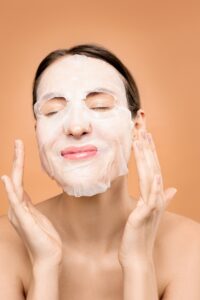How They Work and Which Ones Are Best for Your Skin Type

Face masks have become a staple in many skincare routines, providing a variety of benefits for the skin. However, with so many different types of masks on the market, it can be overwhelming to choose which one is right for your skin type. In this blog post, we’ll explore the science behind how face masks work and which ones are best for different skin types.
How do face masks work?
The purpose of a face mask is to provide a deep cleanse or nourishment to the skin. Different types of masks achieve this in different ways, but generally, they work by:
- Opening up pores: Many masks contain ingredients like charcoal or clay that help to draw out impurities from the skin. These ingredients work by adhering to the skin’s surface and creating a vacuum effect, which pulls out dirt, oil, and other impurities from the pores.
- Providing hydration: Other masks are designed to hydrate and nourish the skin, using ingredients like hyaluronic acid or aloe vera to help the skin retain moisture. These types of masks are especially beneficial for dry or dehydrated skin.
- Exfoliating: Some masks contain physical or chemical exfoliants, like enzymes or acids, that help to remove dead skin cells and promote cell turnover. These masks are particularly helpful for brightening the complexion and improving the texture of the skin.
- Delivering targeted ingredients: Certain masks are formulated with specific ingredients to address particular skin concerns, such as acne or hyperpigmentation. These masks typically contain higher concentrations of active ingredients than regular skincare products, allowing them to penetrate deeper into the skin and provide more noticeable results.
Which face masks are best for different skin types?
There are many different types of face masks on the market, each with its own unique benefits for the skin. Here are some of the best masks for different skin types:
- Oily skin: If you have oily skin, look for a mask that contains ingredients like clay or charcoal, which can help to absorb excess oil and unclog pores. One popular option is the Aztec Secret Indian Healing Clay Mask, which is made from 100% natural calcium bentonite clay and is said to be the “world’s most powerful facial.”
- Dry skin: For dry skin, opt for a mask that provides intense hydration. Look for ingredients like hyaluronic acid, glycerin, or aloe vera, which can help to plump up the skin and lock in moisture. The Laneige Water Sleeping Mask is a cult favorite among skincare enthusiasts, thanks to its lightweight gel formula that provides long-lasting hydration.
- Sensitive skin: If you have sensitive skin, look for a mask that is free from fragrances and other potentially irritating ingredients. The First Aid Beauty Ultra Repair Instant Oatmeal Mask is a great option, as it contains soothing colloidal oatmeal to calm and nourish sensitive skin.

- Acne-prone skin: If you’re prone to breakouts, look for a mask that contains salicylic acid or benzoyl peroxide, which can help to unclog pores and reduce inflammation. The Origins Clear Improvement Charcoal Honey Mask is a popular option, as it contains both charcoal and honey to detoxify and soothe the skin.
- Mature skin: For mature skin, look for a mask that contains antioxidants like vitamin C or E, which can help to protect the skin from environmental damage and improve the appearance of fine lines and wrinkles. The Peter Thomas Roth 24K Gold Mask is a luxurious option, as it contains real gold and colloidal gold to firm and brighten the skin.
How often should you use face masks?
The frequency of use for face masks depends on the type of mask and your individual skin type. In general, it’s best to use a face mask once or twice a week. However, some masks, like those containing exfoliating acids, may be too harsh to use more than once a week, while hydrating masks may be used more frequently. It’s important to read the instructions and follow the recommended usage for each individual mask to avoid over-exfoliating or irritating the skin.
Tips for applying and removing face masks
To get the most out of your face mask, here are some tips for applying and removing it:
- Cleanse your skin thoroughly before applying the mask. This will help to remove any dirt, oil, or makeup that may be blocking your pores.
- Apply the mask evenly to your face, avoiding the eye and lip area.
- Leave the mask on for the recommended amount of time, typically 10-20 minutes.
- Remove the mask gently using warm water and a soft washcloth or your fingertips.
- Follow up with your regular skincare routine, including moisturizer, to seal in the benefits of the mask.

Conclusion
Face masks are a great addition to any skincare routine, providing a range of benefits for different skin types. By understanding the science behind how face masks work and which ones are best for your skin type, you can choose the right mask to help you achieve healthy, glowing skin. Remember to always follow the instructions for each mask and use them in moderation to avoid over-exfoliating or irritating your skin.

